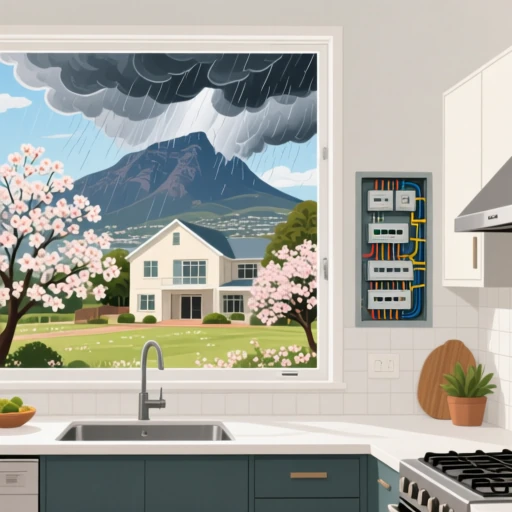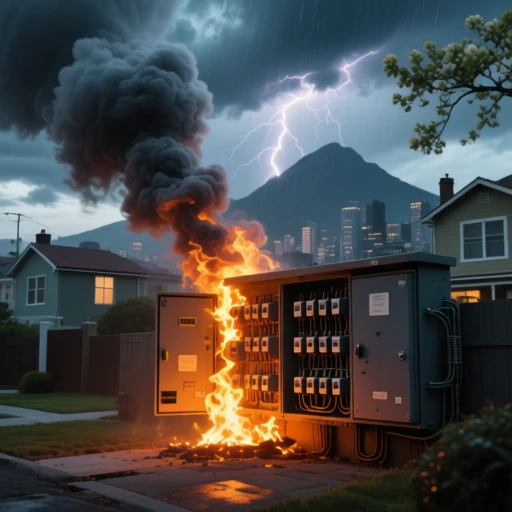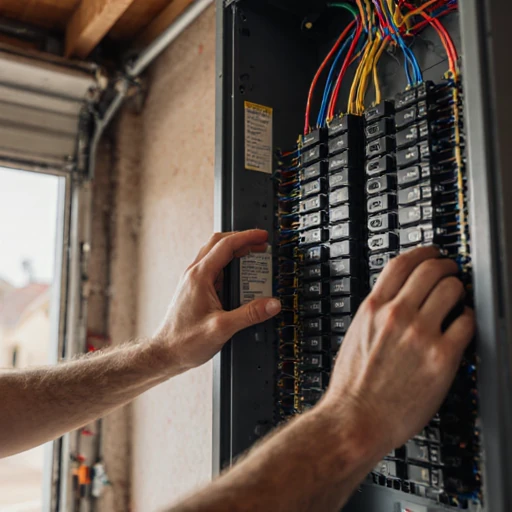As the days grow longer and warmer in Cape Town this mid-spring, many of us are firing up garden tools, outdoor lights, and air conditioners after the chill of winter. But with this seasonal shift comes a hidden risk lurking in your home or business: overloads in electrical distribution boards. These essential components, often tucked away in a utility room or garage, manage the flow of electricity throughout your property. When they overload, it can lead to frustrating electrical outages, or worse. In this article, we’ll dive into the specific challenges Cape Town residents and business owners face during spring, why these issues spike now, and practical ways to identify them early. Whether you’re in a historic Victorian home in the Southern Suburbs or running a bustling shop in the CBD, understanding these problems can save you time, money, and headaches.

The Spring Surge in Electrical Distribution Board Overloads
Let’s start by pinpointing the issue. Electrical distribution boards, sometimes called DB boards or breaker panels, are the heart of your property’s electrical system. They distribute power from the main supply to various circuits, protecting against overloads with built-in breakers or fuses. In Cape Town, where our grid faces ongoing strains from national energy challenges, these boards work overtime. But during spring, from September to November, specific factors amplify the risk of overloads.
One major culprit is the transitional weather. Cape Town’s spring brings fluctuating temperatures, with warm days interspersed by sudden rain showers and gusty winds from the southeast. This humidity and moisture can seep into older electrical systems, causing corrosion on connections within the distribution board. According to local utility reports and electrician insights, moisture ingress accelerates wear on components like busbars and breakers, leading to increased resistance and heat buildup. When resistance rises, the board has to work harder, pushing it toward overload.
Another common trigger is heightened power usage. As we shake off winter, households plug in more devices: pool pumps, electric lawnmowers, and fans to combat the rising heat. Businesses ramp up too, with extended hours for spring events or outdoor setups. In older properties, common in areas like Rondebosch or Observatory, the original electrical distribution boards weren’t designed for today’s gadget-heavy lifestyles. Adding a high-wattage appliance without upgrading can exceed the board’s capacity, causing an electrical fault that manifests as an overload.
Pests also play a sneaky role in spring. Rodents and insects become more active as temperatures climb, seeking shelter in warm spots like distribution boards. They chew through insulation, creating short circuits that mimic or cause overloads. In Cape Town’s suburban areas, where green spaces abound, this is a frequent complaint among electricians. Combined with the aftermath of winter load-shedding, where surges upon power restoration stress the board, spring becomes a perfect storm for these issues.
Finally, aging infrastructure compounds the problem. Many Cape Town homes and businesses, especially those built before the 1990s, have outdated boards with insufficient amperage ratings. Spring’s variable weather exposes vulnerabilities, like loose connections vibrating loose from wind or expanding/contracting with temperature changes. If you’re noticing sporadic power dips, it might be an early sign of an impending overload in your electrical distribution board.
By recognizing these spring-specific triggers, we show that this isn’t just a random glitch but a predictable challenge tied to our local climate and lifestyle. Ignoring it? That’s where things get dicey.
Why Ignoring Overloads Can Lead to Disaster
Now, imagine this: You’re hosting a spring braai at your Sea Point apartment, or your Woodstock cafe is packed with customers enjoying the milder weather. Suddenly, lights flicker, appliances shut off, and you’re plunged into darkness. This isn’t just inconvenient; it’s the tip of a potentially costly iceberg when electrical distribution board overloads go unchecked.
First, the immediate fallout is electrical outages and power outages that disrupt daily life. In Cape Town, where load-shedding already tests our patience, an internal overload can extend downtime, leaving you without essentials like refrigeration or security systems. For businesses, this means lost revenue; a retail store might close for hours, or a home office could miss deadlines. Studies on South African energy disruptions highlight that even short outages can cost small businesses thousands in productivity, and in spring, with longer days encouraging more activity, the impact feels amplified.

But the risks go beyond inconvenience. Overloaded electrical distribution boards generate excessive heat, which can melt insulation and spark fires. According to fire safety reports from the Western Cape, electrical faults are a leading cause of residential blazes, and spring’s drier winds can fan flames quickly. Imagine the horror of a smoldering board igniting nearby materials, endangering your family or employees. Health-wise, repeated outages strain appliances, leading to premature failures, and in medical-dependent homes, like those with oxygen machines, it poses life-threatening risks.
Financially, the toll mounts. Repairing damage from an overload-induced electrical fault often requires replacing the entire board, costing significantly if not caught early. Insurance claims might cover some, but premiums could rise, and downtime adds indirect expenses. In Cape Town’s competitive market, businesses can’t afford reputation hits from unreliable power; customers flock to stable competitors. Environmentally, frequent faults contribute to waste, as damaged components end up in landfills, clashing with our city’s green initiatives.
Worst of all, untreated overloads can cascade into system-wide failures. A single faulty breaker might trip repeatedly, wearing down the whole setup and inviting more severe power outages. In spring, when storms occasionally roll in, this vulnerability heightens, turning a minor issue into a major crisis. The urgency is clear: leaving these problems unsolved isn’t just risky; it’s a gamble with safety, savings, and sanity.
Spotting and Addressing Overloads Step by Step
The good news? You don’t have to wait for a full-blown crisis. With a clear framework, you can spot signs of electrical distribution board overloads early and take action. This approach delivers value right away, empowering you to safeguard your Cape Town property this spring.
Start with visual inspections. Open your distribution board (safely, with power off if possible) and look for obvious red flags. Burn marks, discoloration on breakers, or a musty smell from moisture buildup signal trouble. In spring’s humid air, check for condensation or rust on metal parts, which can indicate corrosion leading to overloads. If wires appear frayed or chewed, pests might be at play; seal entry points and clean the area.
Next, monitor performance cues. Frequent breaker trips are a classic warning of overload. Note if they happen when multiple devices run, like your spring cleaning with vacuum and washer simultaneously. Flickering lights or dimming when appliances start point to voltage strain, often from an overloaded board. Warm outlets or switches elsewhere in the property can trace back to the distribution board pushing too hard.
Use simple tools for deeper checks. A non-contact voltage tester can detect irregularities without risk. Track your energy usage with a smart meter app; spikes in spring might reveal hidden loads straining the board. Listen for unusual sounds, like buzzing or humming from the panel, which suggest loose connections vibrating under load.
Preventively, redistribute loads. In spring, avoid plugging high-draw items into the same circuit; spread them out or add dedicated lines. Upgrade to energy-efficient appliances to ease the burden on older boards. Schedule seasonal maintenance: Clean the board of dust and debris accumulated over winter, and tighten connections to combat expansion from temperature shifts.
If DIY feels overwhelming, document symptoms and consult resources like local electrical codes. But remember, tampering without expertise can worsen issues. This framework not only helps spot problems before they cause electrical outages but builds habits for year-round reliability.

Integrating Professional Help Seamlessly
Within this solution framework, there’s a natural spot for expert input to ensure lasting results. Qualified electricians bring specialized tools, like thermal imaging cameras, to detect hot spots in electrical distribution boards that eyes alone miss. They can perform load calculations tailored to your spring usage patterns, recommending upgrades like higher-capacity breakers without overhauling everything.

In Cape Town, where regulations demand compliance for safety, professionals handle certifications and installations that align with national standards. For instance, if corrosion from spring moisture is the issue, they might suggest weatherproof enclosures or surge protectors to shield against post-load-shedding spikes. This fits neatly into your preventive steps, turning potential electrical faults into non-issues.
At Electrogem, our team of registered master electricians specializes in these diagnostics and upgrades for homes and businesses across the Southern Suburbs. We’ve seen how a timely intervention prevents power outages, keeping your spring vibrant and uninterrupted. Whether it’s a quick fault-finding session or a board refresh, integrating such expertise complements your efforts, providing peace of mind without the hard sell.
By weaving professional services into the mix, you elevate your approach from reactive to proactive, ensuring your electrical system thrives through Cape Town’s dynamic seasons.
Frequently Asked Questions (FAQs)
- What are the most common signs of an electrical fault in my distribution board during spring? Common signs include frequent breaker trips, flickering lights, warm panels, or unusual buzzing sounds, often worsened by Cape Town’s humid spring weather.
- How does spring weather in Cape Town contribute to power outages from overloads? Fluctuating humidity and storms can cause corrosion and surges, while increased appliance use overloads older boards, leading to outages.
- Can I fix an overloaded electrical distribution board myself? Basic checks like redistributing plugs are fine, but for safety, consult a qualified electrician to avoid worsening electrical faults.
- Why do electrical outages happen more in older Cape Town homes? Outdated wiring and boards can’t handle modern loads, especially in spring when usage rises, risking overloads and faults.
- How often should I inspect my electrical distribution board to prevent outages? Aim for seasonal checks, like at the start of spring, or annually by a professional to catch issues early.
Discover signs of winter damage to your electrical distribution board in Cape Town. Learn electrical fault finding tips to prepare for spring – read our recent article here…
